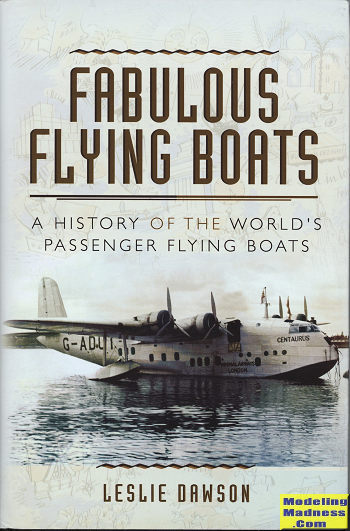 Subtitled
' A History of the World's Passenger Flying Boats', this book provides us with
the story of the use of the flying boat from the 1930's until today. The
subtitle is a bit misleading as it really only covers British flying boats
though others are provided a passing mention, so I guess that qualifies.
Subtitled
' A History of the World's Passenger Flying Boats', this book provides us with
the story of the use of the flying boat from the 1930's until today. The
subtitle is a bit misleading as it really only covers British flying boats
though others are provided a passing mention, so I guess that qualifies.
The book starts off with a history of water borne planes
starting during the early years of flight. According to the author, a Frenchman,
Henri Farbe is the first to fly a plane from water, having done so in a huge and
rather ungainly contraption from the bay at Monaco in 1910. It does touch on the
Douglas Dolphin, the Huges H-4, and the Catalina to name a few as well as boats
from some other nations, but it is pretty obvious that the focus is on British
boats. Not that this is a bad thing as by far, it was the British who developed
long range flying boat service to a high level.
Back then air travel in general and flying boats in
particular were only for the wealthy. Shorts Brothers were the main driving
force in the development of long range boats and for the time, these were very
luxurious aircraft. They had to be as people would be in them for hours or days
on end when flying from one location to the other. The planes carried two full
crews so that the aircraft were able to keep flying.
It is as much due to the expanse of the British Empire,
which at one time controlled 20% of the Earth's land masses that these aircraft
were so important. The 1930s were probably the nadir of the long range passenger
flying boat, operating from harbors, rivers and lakes. Shorts was kept quite
busy producing and developing these boats, as like many other aircraft of the
time, these seem to have succumbed to a rather large number of accidents, some
fatal.
WWII brought an increase in the requirements for long
range patrol boats and the Sunderland, which was based on their passenger boats.
Post war, there was still a need and new boats were designed, though after the
early 1950s and the increase in long range land-based airliners, the need for
flying boats quickly diminished. However, they are not gone entirely. Some were
used by smaller airlines, some were converted to charter flights and some were
put in museums. Many Sunderlands were converted post war for passenger service.
Even today, there are flying boats like the PBY and the Martin Mars that are
used for fire bombers, though the numbers are steadily dwindling.
Some of the more interesting parts of the book are when
the author describes the steps needed to get the boats ready to fly. This
includes a rather detailed description of the amenities and sections of the
boats. One would have wished for more interior photos, but perhaps they just
aren't available. Then there are the stories. Much of the book is filled with
tales of what it was like to fly the planes and what it was like as a traveler.
At over 300 pages, it takes a while to read, but it is
well written and never fails to hold one's interest. I found every page to be
interesting and informative. A book that enjoyed reading as the subject has
always held some fascination for me. I'm sure you will find it equally
absorbing; a book that I highly recommend.
September 2017
Copyright ModelingMadness.com. All rights reserved.
Review book courtesy of
Casemate Publishing, where you can order your copy of this and many other superb books.
You can get this book
at this link. Also available as an e-book.
If you would like your product reviewed fairly and
fairly quickly, please
contact
me or see other details in the
Note to
Contributors.
 Subtitled
' A History of the World's Passenger Flying Boats', this book provides us with
the story of the use of the flying boat from the 1930's until today. The
subtitle is a bit misleading as it really only covers British flying boats
though others are provided a passing mention, so I guess that qualifies.
Subtitled
' A History of the World's Passenger Flying Boats', this book provides us with
the story of the use of the flying boat from the 1930's until today. The
subtitle is a bit misleading as it really only covers British flying boats
though others are provided a passing mention, so I guess that qualifies.